A journey through the falls of the Brecon Beacons is replete with photographic opportunities. Nigel Forster provides an indispensable guide
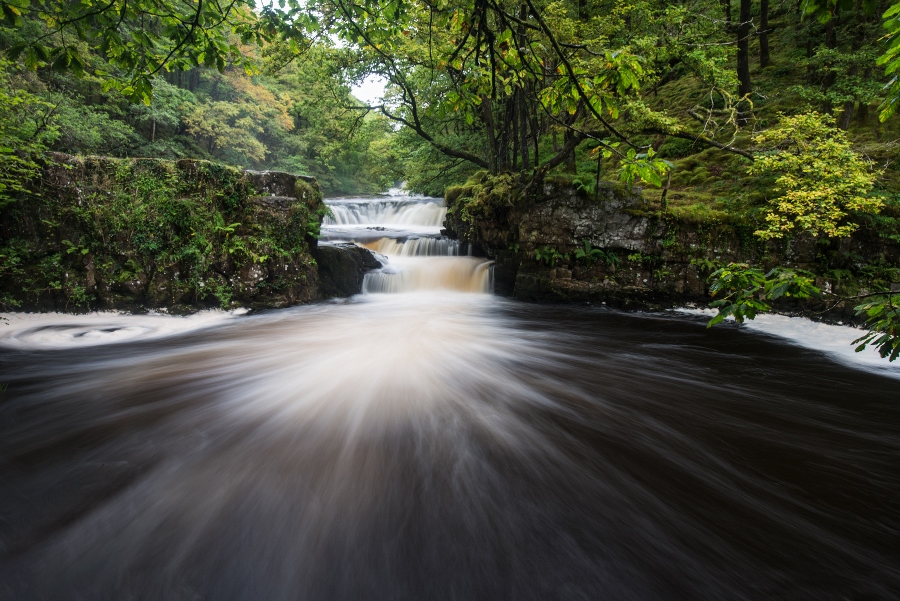
All images by Nigel Forster
Waterfalls are among the most popular of photographic subjects. In this guide I take you through a visit to the Afon Nedd Waterfalls in the Nedd-Fechan Valley, Brecon Beacons, which I undertook in August 2017.
The area is one of the best in the UK for range, scale and number of waterfalls, with water coming directly off the mountains and meeting at the confluence of the Rivers Mellte, Hepste, Pyrddin and Nedd-Fechan, and tributaries of the River Neath, winding their way through Waterfall Country via steep-sided, tree-lined gorges.
Getting there (see maps below)
The waterfalls area is just north of the A465 Heads of the Valleys road at Glynneath around 18 miles east of Swansea.
From the south, access the area from the A465 Heads of the Valleys road and turn off at Glyneath.
From the north, a series of minor roads off the A4059 Hirwaun Road will take you to the Pont Melin-Fach car park, which shortens the walk to the waterfalls and is the route that I have used (i.e. north to south).
It’s best to have a map with you: buy OS Explorer Series OL12, Brecon Beacons National Park, West & Central Areas. The car park is at Grid Ref: SN 906105.
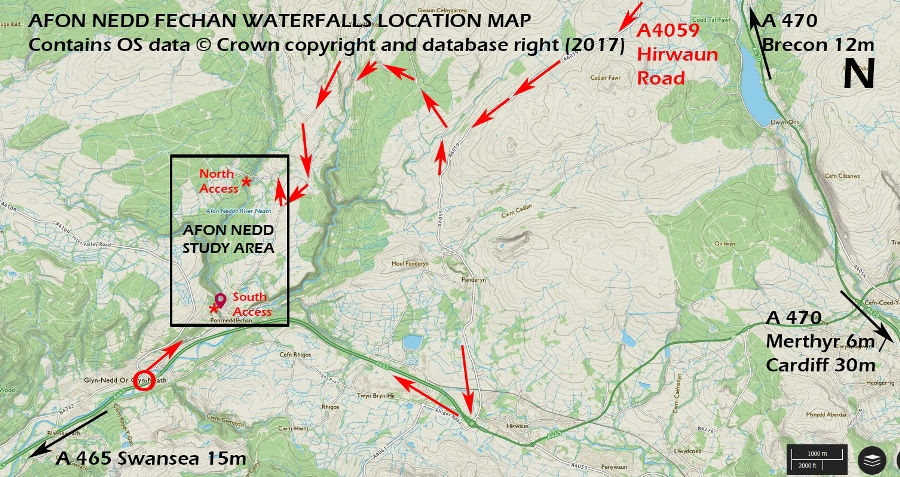
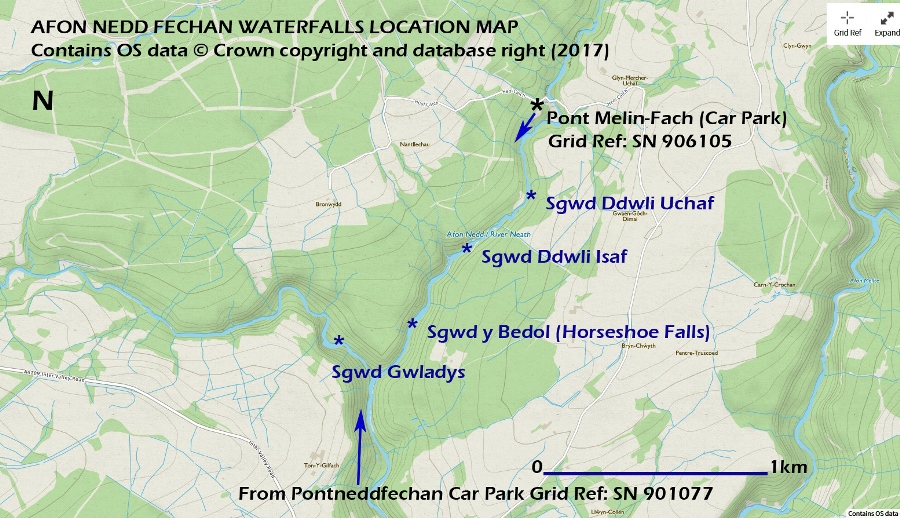
Before you leave, make sure you have the following essentials:
• Your camera and lenses (a wide-angle is good for dramatic foregrounds of water)
• A sturdy tripod
• A remote release for long exposures
• Preferably a set of filters, including neutral density, graduated neutral density and polarising
• Lens / filter cleaners (these will be getting plenty of use!)
• An umbrella (rain and spray are common)
• Walking boots or wellington boots for getting into the water and waterproof clothing
When you leave the car walk past the information point – it contains some useful background to the area – and walk down the path marked “Elidir Trail”. When I did it, the path was very muddy and rocky in places (see the picture below), particularly at the beginning. I say more about staying safe at the end of this paper – please read it in detail.
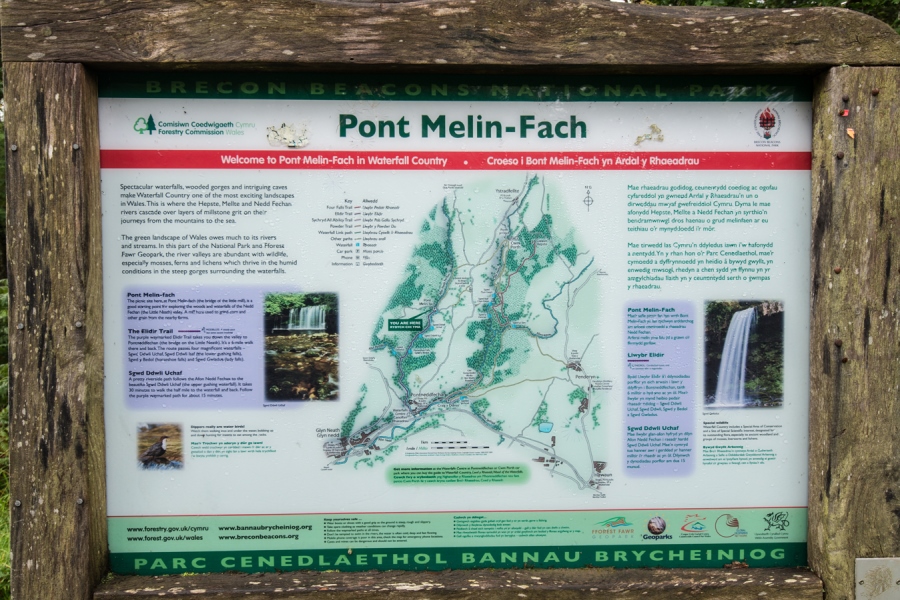
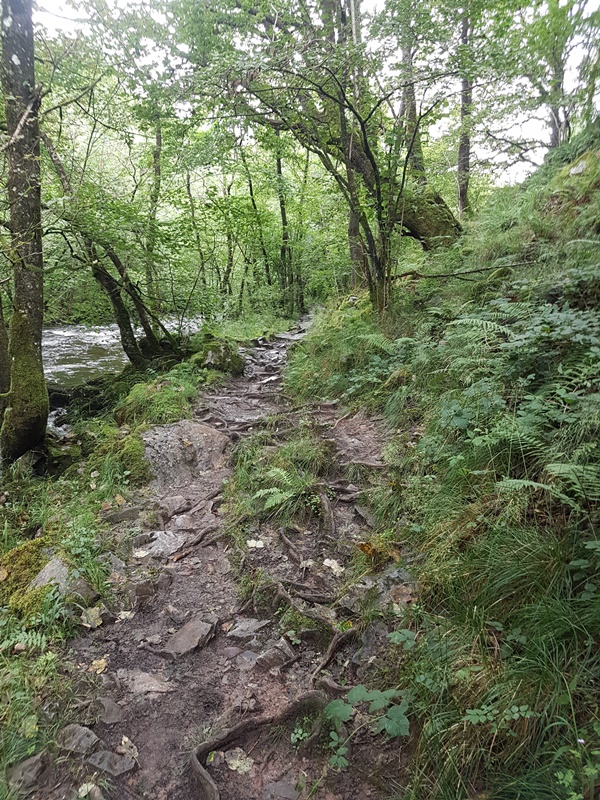
The path can be difficult, particularly in rough weather – watch your step!
The right weather for waterfalls?
The day I went and took most of the images on this blog, there had been heavy recent rain. You might imagine that this is ideal for photographing waterfalls, but in fact it gives rise a number of challenges:
• Water spray into the camera can be a real issue if you get anywhere near the waterfall
• The fine detail and subtleties of the water cascading over rocks can be lost in a sheet of white.
• In the Brecon Beacons, the uplands are made up of peat; in rain, this washes down and turns the water a distinct brown colour rather than the nice white you’d ideally be looking for.
• Surfaces and paths can be made extra-slippery, so even more care is needed
Often the best time to go is a couple of days after heavy rain has passed – you’ll still get sufficient water running off, but not enough to cause the problems listed above. Light rain or drizzle is generally good; the light is flat and even, resulting in minimal shadows and strong colours.
It’s also best to avoid sunny days. The sun reflecting off water can create real difficulties and flatten colours. Waterfalls are also usually in wooded valleys, meaning sunshine can cause a very unpleasant and messy combination of light and shadow. If you do go on a sunny day, try using backlighting on tree leaves; you’ll rarely achieve good results with the sun behind you.
Overcast days with flat light are perfect for waterfall areas and bringing out colours
Location 1 – Waterfall 200m south of car park
Before we get to the main waterfalls, after travelling about 200m from the car park you’ll notice a minor fall. While it’s not the most impressive (and is not individually named), it is worth a quick stop, although it can be difficult to get an effective angle on it. Typically the best position to take waterfalls shots from is directly facing the water; the flow coming directly towards you is generally much more dramatic.
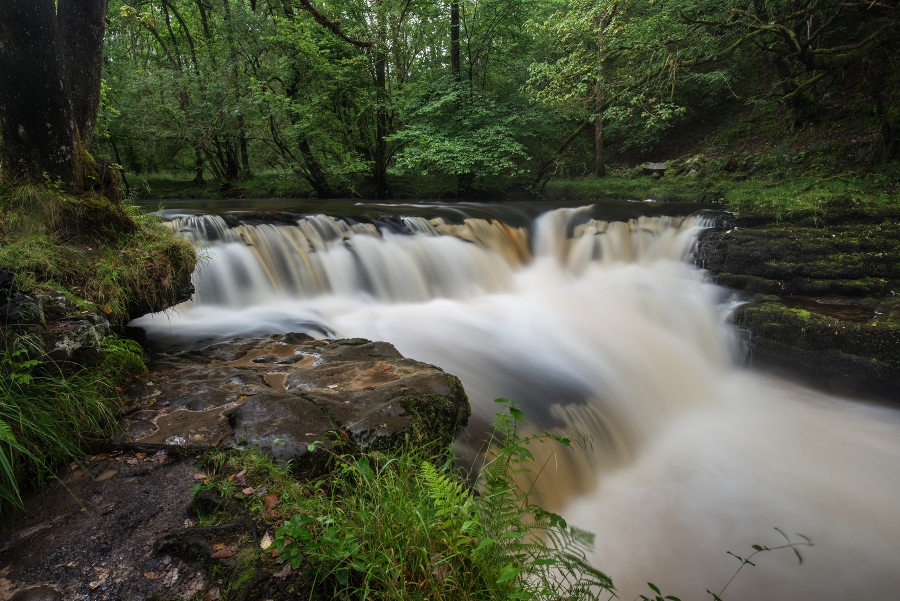
First waterfall: 10 sec, f/16, 16mm lens, ND 1.2 (4-stop) filter to lengthen shutter speed
This is an initial shot taken from the edge of the bank. It results in water running across the frame which can make for an awkward composition. In this situation, try to look for alternative viewpoints, perhaps finding a simple foreground and detail rather than trying to capture the whole waterfall.
Exposure suggestions for shooting waterfalls
Always shoot in RAW for maximum flexibility and control in post-processing.
You’ll often find that waterfalls are bright, but can be a small part of an overall dark scene. If using Average (Matrix / Evaluative) metering, the camera will want to lighten the scene to mid-grey (while in reality it’s a significantly darker tone). This can potentially over-expose the highlights of the water. If using aperture mode, use exposure compensation of -0.7EV, but preferably use manual mode, which allows you to fine-tune the results.
Use the highlights feature on your camera playback options and check the histogram after taking the image to ensure that you’ve retained highlights. Remember though: if the water forms the majority of the image, the camera will darken the white water to grey and you’ll have the opposite problem, meaning you will have to INCREASE exposure.
If you are unfamiliar with manual exposure control, try using spot metering to see how the camera reads the tones.
Focusing suggestions for shooting waterfalls
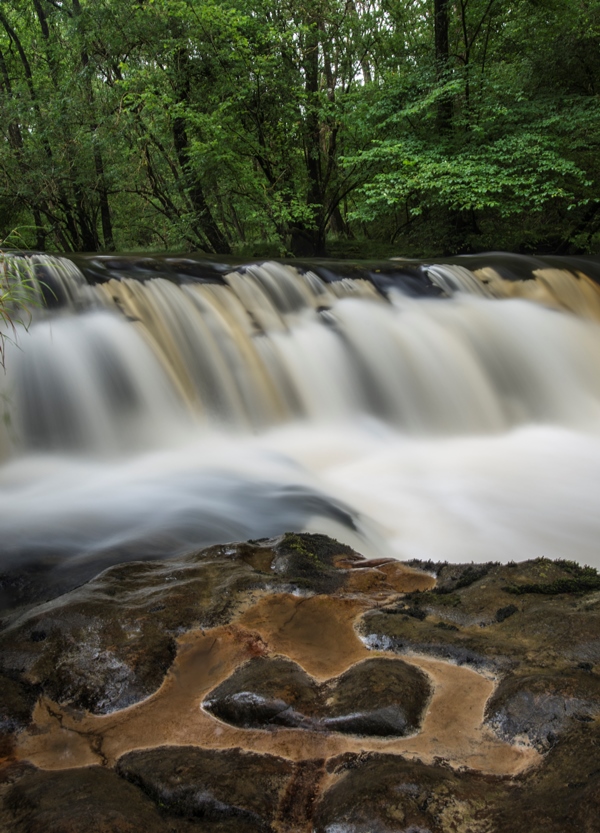
A close up of the foreground rocks with the water and trees in the mid and background. This makes a simple two-colour composition: 10 sec, f/16, 16mm lens, ND 1.2 (4-stop) filter.
With this kind of shot, pay particular attention to depth of field; this type of image generally needs to be sharp from front to back. In this example I used a single focus point on the midpoint (the waterfall) and a small aperture to maximise depth of field. Using a single focus point gives you precise control over focusing. Your camera will be on a tripod, so move the focus point around the screen to the position you want.
Focusing will often be difficult through a dark ND filter; you can’t see through the viewfinder, and autofocus often won’t work through it. Focus before adding the filter, either manually using the gauge on the lens or with the back button. This means that the camera will not try to refocus when you press the shutter.
Walking on
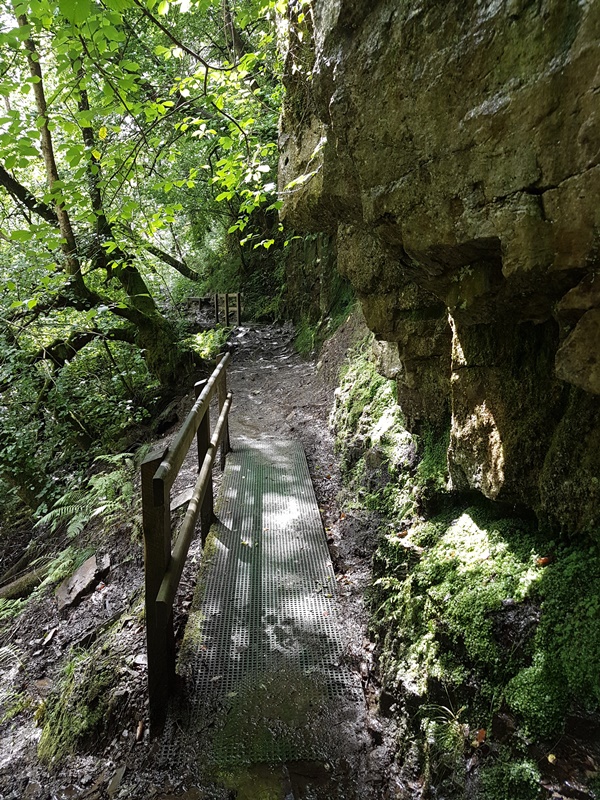
The path gets a little better from this point; it’s less rocky and there are a series of timber bridges across the difficult parts. However, there are still steep paths in places next to the river, so continue to take care.
Location 2 – Sgwd Ddwli Uchaf (Upper Gushing Falls) 500m from car park
This is one of the most dramatic and popular waterfalls in the area. It’s a striking wall of water with a height of 5 metres. There was a real challenge with spray with this waterfall, which made longer exposures particularly difficult. However it’s a great one for facing the waterfall; the central positioning is ideal for maximum impact and drama.
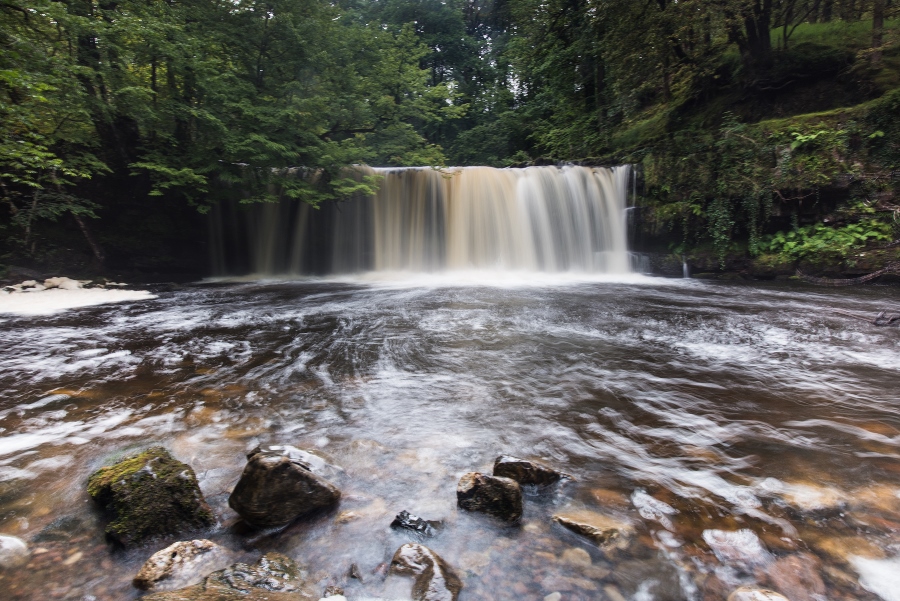
Sgwd Ddwli Uchaf. 1.6 sec, f/14, 0.9 (3-stop) soft graduated ND Filter
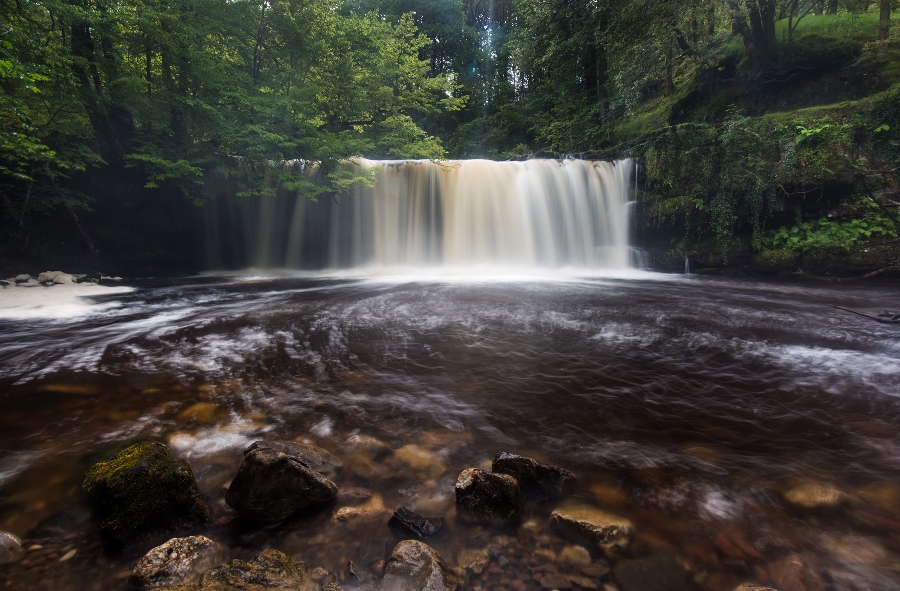
Sgwd Ddwli Uchaf. 1.6 sec, f/14, 0.9 (3-stop) soft graduated ND Filter, polarising filter
As you can see, the addition of a polarising filter makes a dramatic difference to foreground detail and colour and removes reflections from the sky. Polarising filters come into their own under grey or white skies, in a way that cannot be reproduced in post processing. They also increase colour saturation, as reflections are also removed from other shiny surfaces such as leaves and rocks.
With these images, I also used a 3-stop soft graduated filter. The sun was starting to come out between the clouds and I was shooting into the light – the filter helped tone down the highlights at the top of the water. I wanted to try a longer exposure to increase the smoothness in the foreground but was unable to do so because of spray.
Composition suggestions for shooting waterfalls
• You’ll usually get more drama by shooting from the water towards the waterfall; it maximises the effect of the water coming towards you.
• Try to contain the highlights within the image; the water will typically be the brightest part if the image and will usually work best if the darker tones are around the edges, containing the highlights. For this reason, you’ll often want to exclude the sky, particularly if it’s a competing highlight at the edge of the frame.
• Don’t just look at the main waterfall; capture images of details, isolated flows of water, the play of the light and other things that catch your eye.
Location 3 – Sgwd Ddwli Isaf (Lower Gushing Falls) 800m from car park
Spray was a problem here as well, but not as much as the sheer volume of water, which prevented me from getting a strong image facing the waterfall. The image below does highlight one difficulty with long exposures: there’s significant movement in the leaves (even on a still day such as this, the waterfall creates its own wind turbulence).
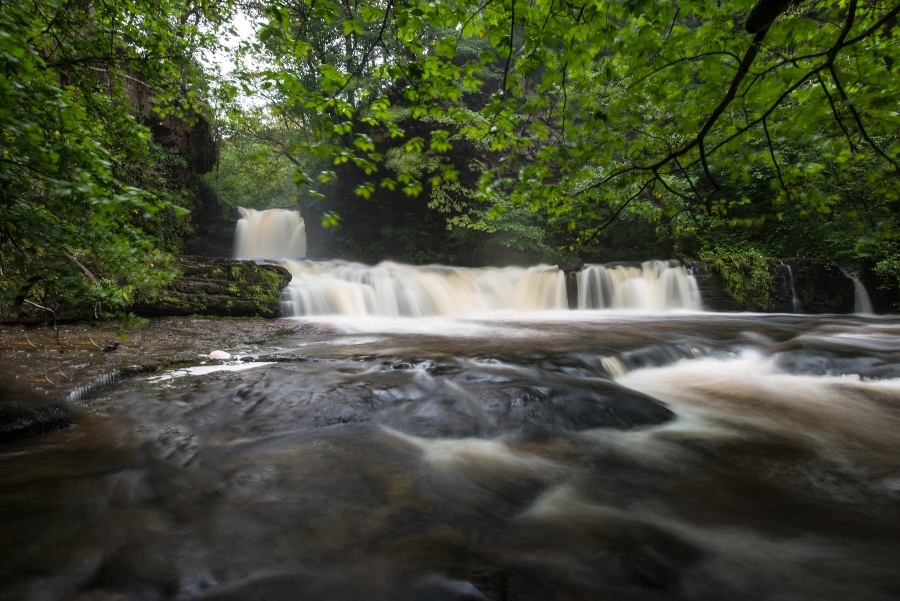
The main issue to watch out for with this location is the very slippery surface on the rocks you need to walk over to get to the base of the waterfall, especially if they are wet. Tread very carefully and keep your camera in the bag until you need to use it. When water levels are lower here, there are a series of rock pools that make for interesting still water reflections.

At the same location I produced two images of water splashing over rocks under a light flow of water from above. The first (left) is 1/10sec and the second (right) is 15 sec. The difference is subtle but interesting.
Filters for shooting waterfalls
As with any aspect of landscape photography, the only filters you will need are neutral ones that simply control the quantity and quality of light. Don’t be tempted by coloured or special effects filters.
• Neutral density filters: These simply reduce the light coming into the sensor to allow you to use longer shutter speeds with water movement (and allow the use of larger apertures). A 6-stop (ND 1.8) filter will normally be sufficient for the weather conditions and shutter speeds, particularly as you’ll be combining with a polarising filter. I use an ND 1.2 (4-stop) ND filter most often with waterfalls
• Graduated neutral density filters: These balance exposure variations, typically with sky and land. However I use them infrequently with waterfalls, as I usually exclude the sky in any case. The presence of vegetation and uneven land profile will mean you’ll typically use a soft graduation of 2-3 stops strength.
• Polarising filters: As illustrated with the examples here, these are very useful when shooting waterfalls, where images tend to be full of reflective surfaces and glare from the sky. The presence of a polariser results in a dramatic increase in visible detail and colour saturation.
Location 4 - Sgwd y Bedol (Horseshoe Falls) 1.2 km from car park
These falls are the last before the Afon Nedd meets with the Pyrddin Tributary, in which you’ll find the larger falls of Sgwd Gwladys. You’ll reach the upper level of this waterfall first – I struggled to keep the spray off here more than any other. A comparison with my last visit there is interesting to see.
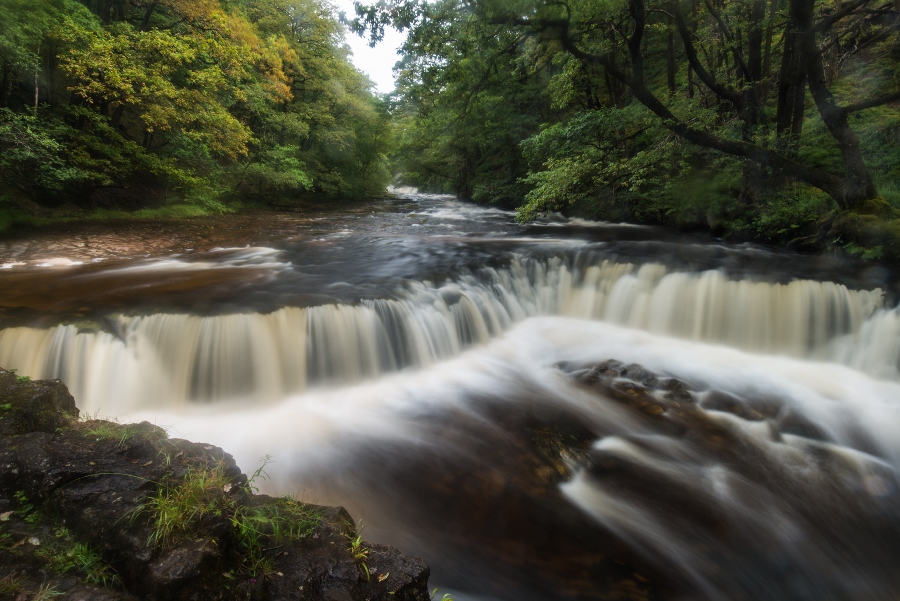
Sgwd y Bedol, 6 sec, f/18, 16mm lens, ND 1.2 (4-stop) filter
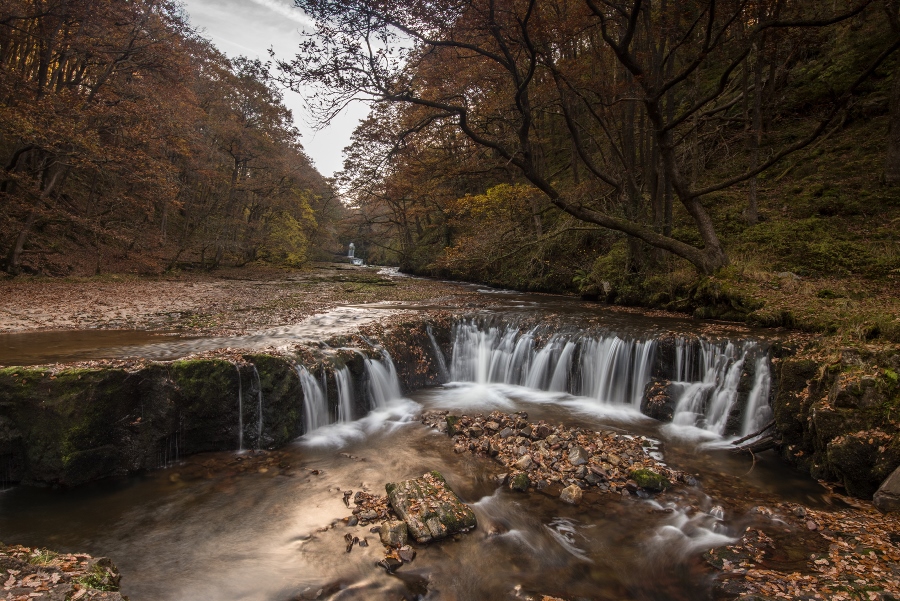
Sgwd y Bedol in autumn 2016: 2.5 sec, f/16, ND 1.2 (4-stop) filter
Just below this, I found the most interesting shot of the day. I was further way from the falls which kept me clear from the spray. A rock outcrop protruding into the river allowed me to face the waterfall and enabled me to get a strong symmetrical composition.
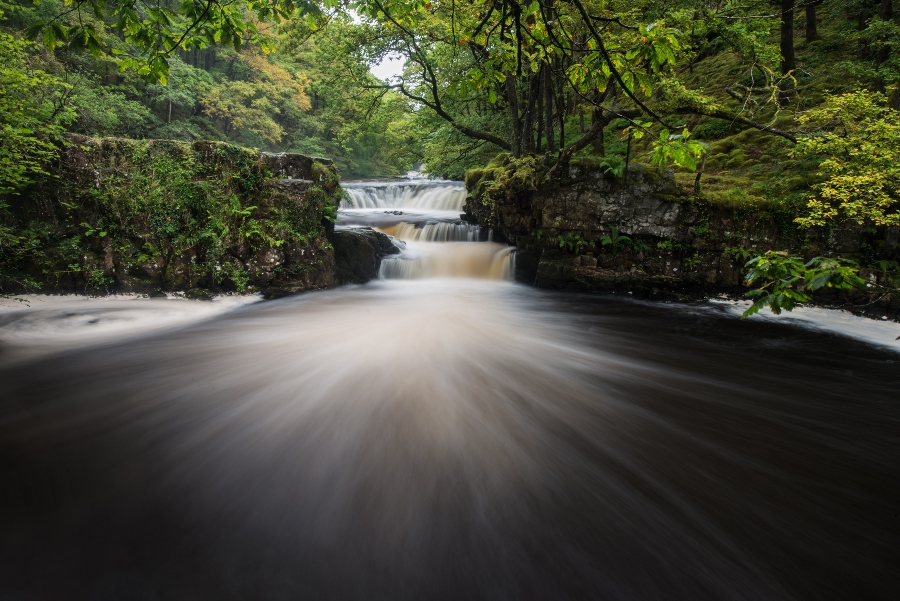
Sgwd y Bedol, 20 sec, f/22, 16mm lens, ND 1.2 (4-stop) filter, polarising filter

Sgwd y Bedol, 5 sec, f/11, 16mm lens, ND 1.2 (4-stop) filter, polarising filter
There is an interesting comparison between the 20 sec shot (top) and the 5 sec shot (bottom). The lines created by the froth in the water (which comes from the peat) are more prominent in the shorter exposure, and the contrast is greater.
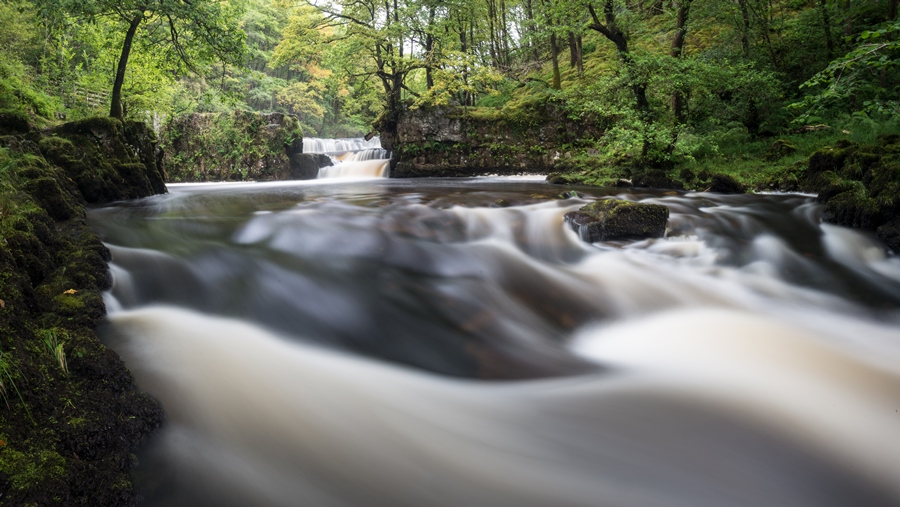
Sgwd y Bedol, 2-shot panoramic. 30 sec, f/20, 16mm lens, ND 1.2 (4-stop) filter, polarising filter
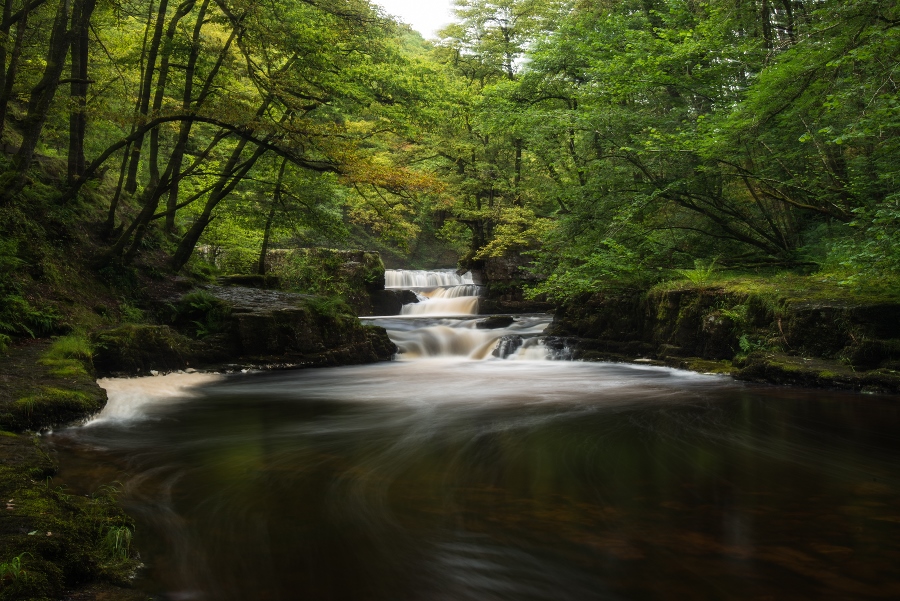
Sgwd y Bedol, 20 sec, f/15, 16mm lens, ND 1.2 (4-stop) filter, polarising filter
I then walked a little further down and found a spot in which I could get very close to the water and emphasise the highlights. From the same spot, I then used a 50mm standard lens and captured a different image. I particularly like the subtle white trails in the water in the lower image. The dark foreground also contains the image and draws the eye to the series of falls.
Location 5 – River Near confluence with Pyrddin Tributary 1.5 km from car park
For this image I had to stand in the water with wellies on, but it was worth the effort; I like the colours in the rocks and texture in the water. This is a composite of three images merged in post processing, taken on a previous trip in May.
Bottom of Afon Nedd. 3-shot stitched image, 2.5 sec, f/22, 16mm lens, polarising filter
The polarising filter was essential to bring out the colours in the rocks. Youneed to use a long enough exposure to make sure that the water blends well – with a short exposure, the water will have a different structure and often won’t blend at all. I looked for a position which maximised the appearance of the rocks in the water, as they make a stronger base to the image.
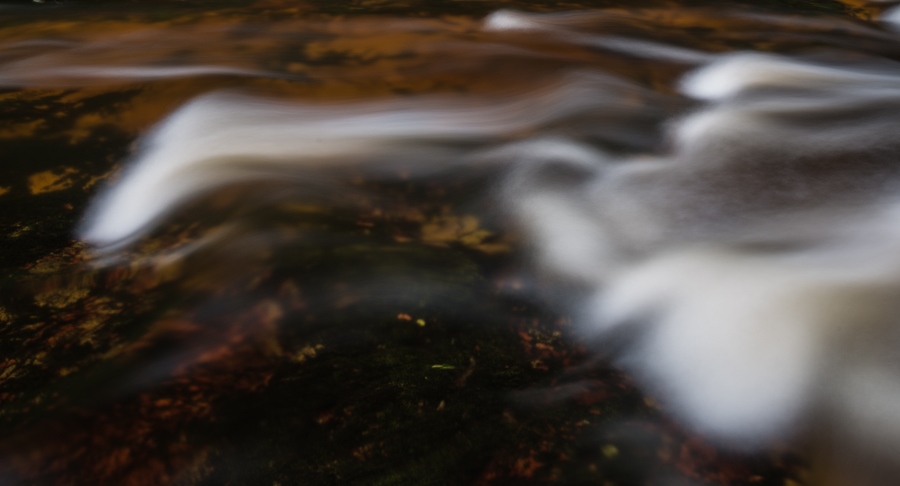
Bottom of Afon Nedd. 20 sec, f/16, 50mm lens, ND 1.2 (4-stop) filter
Finally I took a shot of the flow of water running across the frame – not as successful though.
Location 6 – Sgwd Gwladys (Lady Falls)
Sgwd Gwladys is a five-minute walk at a wooden bridge where the two rivers join. It’s the highest fall in the area and drops out of a bowl of rock – an impressive sight in full flow! The images I’ve included here were taken on previous visits, as this time the sun came out and created very difficult lighting. There were also a number of other people swimming in the water on this visit!
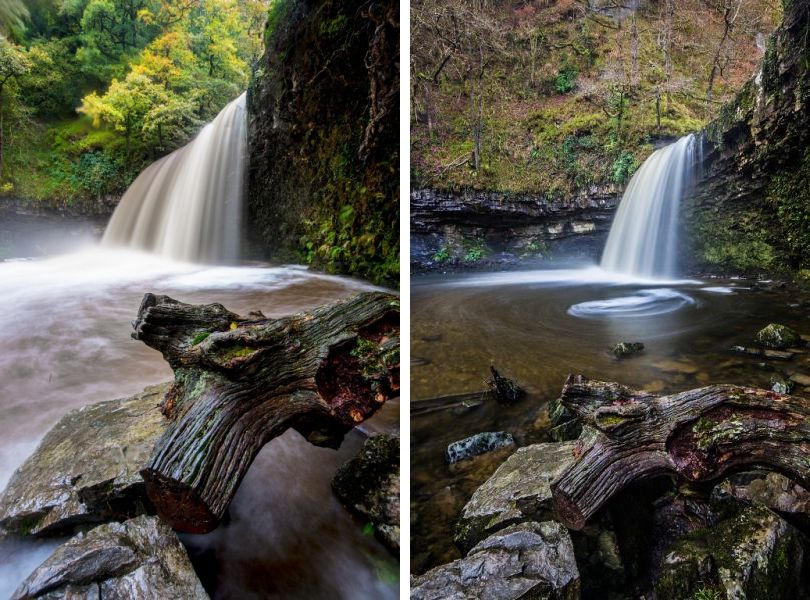
Left: 6 sec, f/18, ND 0.9 (3-stop filter), 24mm lens. Right: 20 sec, f/29, ND 1.2 (4-stop) filter, 20mm lens
The log made a great foreground (although it’s rapidly eroding)! These are autumn &and winter shots, one after heavy rain and one (on the right) in winter in relatively dry conditions. It’s a good comparison because it shows how much more subtle the water flow is when there is less of it.
The significant thing is the effect created at the base of the waterfall with a 20 sec exposure. The water flow creates a circular motion of froth in the water which forms a spiralling effect. The same effect can be achieved with autumn leaves.
The walk back
You’ll find that you can’t walk any further here. Either backtrack and return to your car, or walk five minutes back to where the two rivers join and walk south to Pontneddfechan (about another half-hour walk). Your reward is a pub, The Angel, at the entrance to the walk.
If you want a very long day, you can complete the loop via the other waterfalls in the area (including Sgwd yr Eira, the one you can walk underneath). However this loop, while a good brisk day walk, is too much to cover in a day’s photography. It makes a perfect second day for your trip to the area!
Finally – stay safe!
Any area such as this has potential hazards. This route has particular wet and rocky paths, with slippery rocks near the waterfalls and fast-flowing water at all locations.
Take great care, and remember the following key points:
• Never stand in deep or fast moving water to take pictures from, even if the vantage point may be better. Currents can be strong, and ground conditions underneath extremely slippery. Never, ever stand near the top of a waterfall.
• Always wear waterproof walking boots and clothing.
• Never keep your camera on a tripod while walking on uneven or slippery ground or near water. Always remove it from the tripod and pack it away before moving to a new position. This is because if you do slip, your first instinct will be to protect the camera rather than yourself!
• Do not leave any item of your equipment in a position where it may be a hazard to any other person in the area. This is of utmost importance in an area such as this with limited access and dangerous hazards.
About the Author
Nigel Forster is an experienced tutor in landscape photography, a Master Photographer with The Photographer Academy and runs regular 1-1 and Group workshops throughout the year from his base in the Brecon Beacons, other great locations in Wales and other areas of the UK. For details visit www.creativephotographywales.com.
Related articles
Why You Should Revisit Landscape Locations
Composition – A Guide to Keeping It Simple
Shooting Landscapes with an Ultra-Wide Lens

